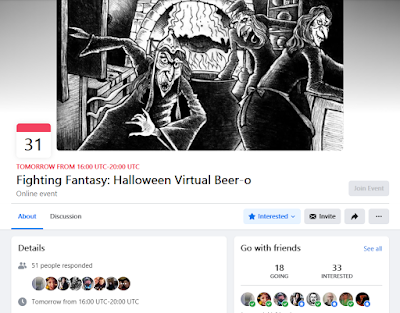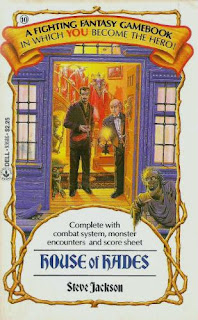For almost thirty years following
its initial release back in 1984,
House of Hell remained unique; it was the only FF adventure to have a
wholly ‘contemporary’ setting. It was not a futuristic, superhero sci-fi yarn,
or a post-apocalyptic adventure, but was Fighting Fantasy’s one and only
specifically horror-themed adventure. That was until
Blood of the Zombies was published in 2012.
There have been other FF
adventures that play with familiar horror tropes – notably books like
Vault of the Vampire,
Moonrunner and
Howl of the Werewolf – but all of these are primarily fantasy
adventures with a good dose of horror thrown in.
House of Hell , on the other hand, is the sort of nightmare you
could imagine yourself ending up in if your car broke down on a lonely country
road in a thunderstorm only for you to discover that you were in a mobile phone
dead spot.
Other than the fact that there’s
no mention of mobile phones, the plot of the book hasn’t dated in the
intervening decades. As a result of the aforementioned breakdown and
thunderstorm, the hero takes refuge in an old house, but it’s a decision that
turns out to be the worst mistake of his life, since the house is home to a
cult of devil-worshippers and their demonic Master.
House of Hell first appeared in a shortened form (only 185 references this time) in
Warlock magazine. A significant number of references were modified for the paperback version, with rooms being moved
around and secret passageways added.
Although his artwork later appeared on the cover for The Citadel of Chaos, House of Hell was Ian Miller’s
first work for the Fighting Fantasy series.
“I got the job through the art agency Young Artists, which
is now known as Arena,” Miller told Alex Ballingall when he was interviewed for
the Fighting Fantazine in 2012. “I did a series of roughs, four I think, and
Steve chose the version he liked best. It was an easy process.
“When I did cover work (I’m not often asked these days), I
worked maybe one or two up on the published book size. The image would be
penciled in, then inked and coloured. I used Illustration board for the most
part… I always read the books I did covers for. It made sense in my opinion… I
think the first, House of Hell, was
the best of the bunch.”
Steve Jackson was so impressed by Miller’s work on House of Hell that he purchased the
original painting.
The book was illustrated internally by Tim Sell. However, one
of his illustrations was removed from subsequent printings after a number of complaints
were received by Puffin Books.
The illustration in question accompanied paragraph 264 and
depicted a naked woman on an altar dripping with blood (although her modesty
was protected by a convenient cultist’s sleeve). The result of the removal of
the illustration was that paragraphs 255 through to 263 had to be moved about
and spaced out with additional filler pictures.
“That did give us a problem,” recalls editor Philippa
Dickinson. “We had a lot of complaints. The media suddenly got hold of, ‘was
this suitable for children?’ We had various, no doubt very well-meaning people,
claiming that we were encouraging children to believe in Satan and Satanism... I do remember one of the people who was interviewed for
television said that her child had come out with the mark of the Devil on his
body and when she threw the book into the fire the marks on his body
disappeared.
“It was of that time, and it was because the books were so
successful, and boys were getting so obsessed, so what were we doing? They were
being obsessed by something, so this can’t be healthy, because they’re
obsessed. But they’re reading! What are you complaining about?"
When
House of Hell was released in the US it was renamed as
House
of Hades, since ‘Hell’ was a more common swear-word with religious
connotations in America than it was in the UK.
“In the middle of all of this craze, and all of the people
saying that we were corrupting children, we also had as many, if not more
people saying, ‘Thank God! My son is finally reading.’" says Dickinson. "Boys were
reading because they saw it as a game, not a book. They were reading because
everybody else was doing it.”
This wasn’t the only time that Fighting Fantasy courted
controversy. The FF series has had its fair share of vehemently outspoken
enemies in the UK.
“The Evangelical Alliance published an eight page warning
guide about the potential danger of reading Fighting Fantasy leading to devil
worship!” says a clearly stunned Livingstone. “And a worried housewife in
deepest suburbia reportedly said on radio that after having read one of my
books, her son levitated. Kids thought, ‘Great – for £1.25 I can fly!’ This was
all wonderful PR for Fighting Fantasy.”
Did you know...?
The dedication written by Steve Jackson for the Wizard Books
edition of House of Hell reads:
Games Night —
to Clive, Ian, Mark, Peter and Skye.
May their Dinner Winnerships be few.
But always more than mine...
The list of names are the members of an exclusive gaming
group that’s been running since the mid-1990s, and
which includes Peter Molyneux of Lionhead Studios fame among its membership. Games Night is still a regular event,
and at the end of each season a cup is awarded.



















